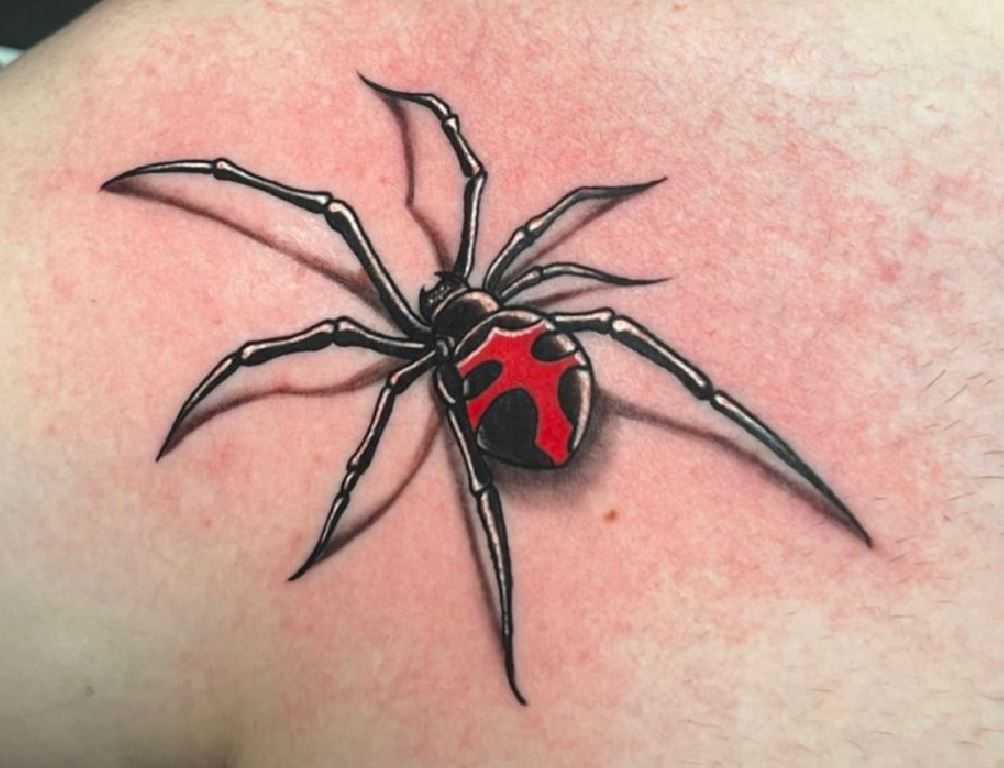A spider tattoo is a symbol that holds great power, capable of stirring up a wide range of emotions, from admiration to fear. Spiders have always been connected to different cultural and spiritual interpretations due to their intricate and mysterious nature. When it comes to tattoos, the spider is often quite eye-catching when depicted using bold black and shadowy gray colors. This helps to highlight their enigmatic and mysterious qualities. On the other hand, using a more vibrant and lively approach can also be quite captivating. Colors like deep reds or blues can make a spider’s appearance more detailed and interesting. On the other hand, golden or silver shades can give a spider a more magical or mythical look.
1. Best part of the body that can contain a Spider tattoo
Spider designs are so versatile that they can be customized to fit almost any part of the body. You can choose to have smaller and more delicate spider tattoos placed gracefully on your wrist, ankle, or behind your ear. If you want to make a bold statement, you can consider placing your tattoo on your chest, upper arm, or calf muscles. Spiders can also be shown crawling up the neck, back, or along the forearm, using the body’s natural curves to make them look even more realistic and creepy.
2. Why people should choose a Spider tattoo
The decision to have a spider tattoo extends much beyond its surface attractiveness. Spiders are recognized as expert weavers because of their ability to create elaborate webs that not only serve as homes for their prey but also as traps for them. Because of this, they are connected to the ideas of creation, tenacity, and success. Spiders represent perseverance, patience, and the cyclical aspect of life in a number of different civilizations around the world. In addition, because they are creatures that are frequently misunderstood or vilified, they might stand for triumphing over adversity or facing one’s anxieties because of their history. Some people believe that getting a spider tattoo represents the power of the feminine, rebirth, and the connectivity of all forms of life. The decision to have a tattoo of a spider can express a significant personal connection to the aforementioned concepts, turning the tattoo become more than just a work of art but also a profoundly personal statement.
3. How to take care of a Spider tattoo
Tattoo aftercare is essential regardless of the design, and a spider tattoo is no exception. Proper care ensures that the tattoo remains vibrant and infection-free. Here’s a guideline:
- Immediate Care: After your tattoo session, your artist will likely cover the tattoo with a thin layer of ointment followed by a protective bandage or plastic wrap. Keep this covering on for a few hours to protect against contaminants.
- Gentle Cleansing: Upon removing the bandage, wash the tattoo gently with lukewarm water and a mild, fragrance-free soap. Use your fingers (not a cloth) to cleanse and avoid scrubbing. Pat the area dry with a soft towel.
- Moisturization: A few hours post-cleansing, apply a light, fragrance-free moisturizer or a specialized tattoo aftercare product. This hydrates the skin and aids in the healing process.
- Limit Sun Exposure: Fresh tattoos are vulnerable to the sun’s UV rays. To prevent fading or damage, keep the tattoo covered or apply high SPF sunscreen if exposed.
- Avoid Soaking: Do not submerge your tattoo in water for extended periods, meaning baths, swimming, or saunas are off-limits during the initial healing phase.
- Resist Scratching: As the tattoo heals, it may peel or itch. Refrain from scratching or picking at it to maintain the integrity of the design and ink.
- Follow Artist’s Recommendations: Always adhere to aftercare instructions provided by your tattoo artist as they may have specific guidelines based on their experience and the tattoo’s specifics.
4. How to remove a Spider tattoo
If you decide to remove your spider tattoo, understand that the process can be more challenging than getting the tattoo itself. Here’s an overview:
- Laser Removal: The gold standard for tattoo removal, lasers target the tattoo’s ink pigments, breaking them down. Over time and several sessions, the body naturally disposes of these particles, causing the tattoo to fade. While effective, it can require multiple sessions and can be uncomfortable.
- Dermabrasion: This process involves sanding down the skin to reach the ink and remove it. It’s less effective than laser removal and can be quite painful.
- Surgical Excision: For smaller tattoos, surgical removal might be an option. The tattooed skin is cut out, and the surrounding skin is sutured together.
- Tattoo Removal Creams: Several creams claim to fade or remove tattoos. Their effectiveness is widely debated, and they often don’t offer the results of more professional methods.
- Cover-Up Tattoo: Another approach is to work with a tattoo artist to design a new tattoo that can effectively cover the old one.
When considering tattoo removal, it’s essential to consult with professionals who specialize in the process. They can offer advice tailored to your specific tattoo and situation, ensuring the safest and most effective approach.
Spider tattoo pictures
Spider tattoo on hand
Number 1

Number 2

Number 3

Spider tattoo on neck
Number 4

Number 5

Number 6

Spider tattoo on belly
Number 7

Number 8

Number 9

Spider tattoo on leg
Number 10

Number 11

Number 12




